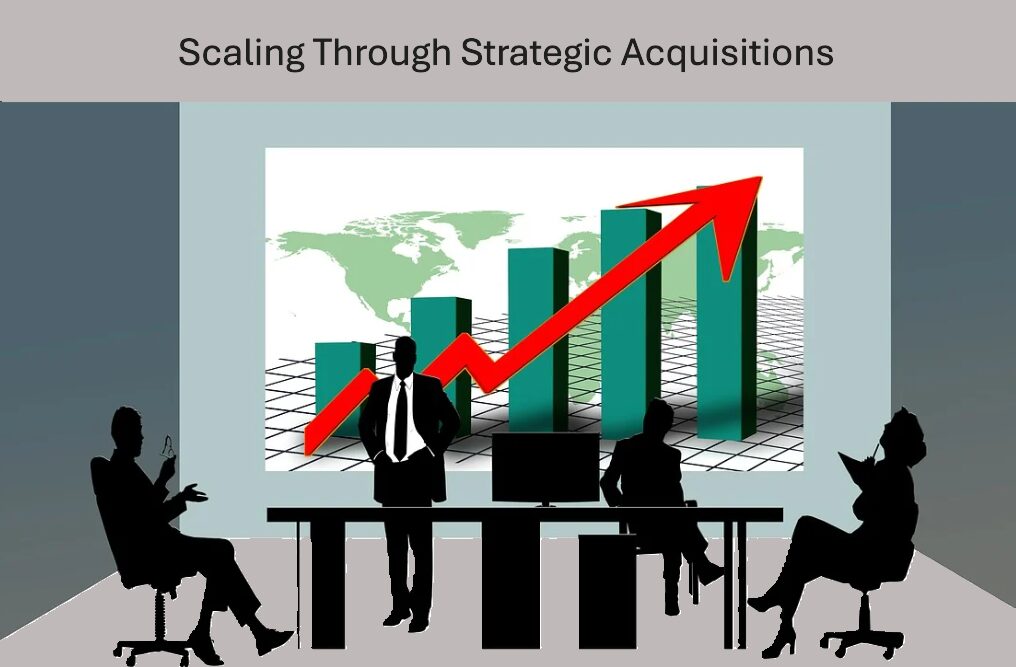Accelerating growth and scaling through strategic acquisitions is a highly effective approach for companies across all sectors. You’ll identify and acquire upcoming businesses to grab a larger market share or expand into new geographical locations.
Buying and integrating innovations is crucial not only for remaining competitive but also for driving growth. You’ll also gain access to a broader customer base and enhance the brand’s credibility. Acquiring or entering into tactical partnerships is a value-driving milestone to becoming a reputable multinational brand.
Strategic M&A deals, when executed with precision and careful planning, unlock synergies that would otherwise take years to develop. However, you will need an expert M&A consultant to assist with identifying the right partners and conducting due diligence.
You’ll also leverage their support to ensure seamless integration, which can make or break the deal. Pooling your strengths and eliminating weaknesses can result in a robust legacy company that can quickly overtake the competition.

*FREE DOWNLOAD*
The Ultimate Guide To Pitch Decks
Scaling Through Strategic Acquisitions is Relevant for All Growth Stages
Regardless of your company’s growth stage, you’ll look for strategic partners that can add value. The deal should have the potential to take the company to the next level. Here’s how:
M&A at the Pre-Seed and Seed Stages
Technology experts and professionals creating Intellectual Property (IP) and Intangible Assets (IA) don’t necessarily have the skills to monetize them. Their strategy is to partner with entrepreneurs who have the expertise to build a company around their intellectual property.
These tech experts understand that building a company involves several complex aspects. Most prefer to concentrate their time and bandwidth on building new products. Their partners take over the task of identifying the right markets and creating the ideal product-market fit.
Reaching out to customers with aggressive and targeted marketing and advertising helps transform the IP into marketable products. On the flip side, not all entrepreneurs have the skills to develop new IP. Their strategy is to purchase the assets from patent owners or hire developers.
In this case, the acquisition is more of an acqui-hire approach, where founders create a team of top talent. They bring on board the necessary skill sets and have them generate the IP. Alternatively, entrepreneurs may purchase IP and patents, saving time that would otherwise be spent developing them in-house.
This strategy accelerates product creation, which is crucial to staying ahead of the competition. The tech sector, which is evolving rapidly, particularly sees more of these M&A transactions. Both–founders and tech developers–benefit from the partnership and get products out into the market quickly.
Acquiring IP and tech capabilities is only one example. Larger, better-established brands may enter into tactical M&A deals to build a market presence in unexplored territory. They can achieve this by acquiring a smaller company with a dedicated customer base and expanding its operations.
The acquired company also stands to benefit by partnering with the bigger brand and getting access to economies of scale.

Raise Capital Smarter, Not Harder
- AI Investor Matching: Get instantly connected with the right investors
- Pitch & Financial Model Tools: Sharpen your story with battle-tested frameworks
- Proven Results: Founders are closing 3× faster using StartupFundraising.com
M&A at the Series A Stage
Using the scaling through strategic acquisitions approach, companies at the series A stage can grow quickly. At this stage, their strategy is to purchase smaller companies with unique talent and skill sets. Smaller companies often lack the resources and expertise to ramp up production and scale effectively.
They can leverage the manufacturing infrastructure that their bigger counterparts have already set up. Simply having groundbreaking technology and ideas isn’t enough. Startups can take years to raise adequate funding and build manufacturing units that are cost-effective and efficient.
A more practical option is to partner and integrate with a brand that has the capabilities. It will also likely have established supply and distribution channels, a well-defined advertising and marketing budget, a robust social media presence, and effective customer acquisition strategies. In short, all the assets needed to launch sales.
The larger brand also benefits, as building a team with top-notch expertise is time-consuming. It will have to invest in recruiting, hiring, onboarding, and training new people. Further, research and development initiatives can take years to yield any real value.
Acquiring an upcoming startup with proven talent that has already developed IP is more economical. At most, partners may need to invest time and resources in streamlining integration and achieving cultural synergies.
The smaller startups typically cease operations entirely. Their founders may choose to remain on the management board of the acquiring company per the terms and conditions of the M&A deal. Others may see the acquisition as an opportunity to make a strategic exit to move on to their next venture.
M&A at the Series B Stage and Beyond
Mergers and acquisitions at the series B stage are more about expanding the established company’s product portfolio. It is well-positioned to enter into horizontal and vertical partnerships at this stage. Its objective is to build an end-to-end ecosystem with complementary products and services.
Scaling through strategic acquisitions enables the company to serve a much broader customer base, possibly in nationwide locations. By partnering with local brands, the company could also explore cross-border M&A deals to expand into global markets.
This strategy allows for faster penetration in new markets. The local startup provides the data and expertise about customer preferences and buying habits that the acquirer can match.
Further, customers loyal to a local company are more willing to accept a partnering newcomer thanks to the transfer of brand value. Without this M&A transaction, it would be far more challenging for the company to build a presence in an unknown location.
At the series B stage, companies are poised to enter deals that enable them to offer customers package deals. Bundling products and services accelerates growth, as the company has established brand value and credibility. Customer loyalty contributes to rapidly growing sales revenues.
At this point, the company has become a trendsetter of sorts, establishing benchmarks for quality standards that newcomers must match. It has exceptional knowledge of the industry. Customers see it as an authority, relying on the brand for the latest tech developments and updates.
Reports suggest that scaling through strategic acquisitions has proven highly successful. Companies that enter into an average of five deals per year grow twice as fast as others with fewer deals. Further, each subsequent deal costs them around 38% less, making M&A more cost-effective.
How Acquiring Companies Ensure Their Objectives Are Met
When larger companies enter into strategic acquisitions, they invest more than just capital and resources. Successful integration is crucial not only to ensure that they meet their goals for rapid growth, but also because their reputation hinges on it.
Here’s what they can do to ensure the M&A transaction is executed flawlessly.
Identifying and Selecting the Right Acquisition Targets
Identifying and selecting suitable candidates for an acquisition is a complex task, which is why hiring an expert is advisable. You’ll look for startups whose assets align with the company’s needs. Start by listing the tech and IP, market reach, or team’s skill sets and talents.
This step is crucial to ensure that you accurately value the target and its assets, allowing you to structure the deal accordingly. Don’t overlook the cultural aspect and the founder’s vision, since that can impact the post-acquisition integration.
Once you’ve finalized the right candidates, you’ll move on to the due diligence phase, which covers legal and financial aspects. You’ll also conduct financial audits, compliance checks, and reviews of licenses, contracts, and IP ownership titles. Make sure there are no legal encumbrances.
This step is significant with regard to the specific assets you’re interested in acquiring. For instance, let’s assume you intend to capture the existing customer base in a location. In that case, you’ll ensure the target has the desired market reach and enjoys some measure of monopoly.
Keep in mind that storytelling is everything in fundraising, mergers, and acquisitions. In this regard, for a winning pitch deck to help you here, take a look at the template created by Silicon Valley legend, Peter Thiel (see it here) that I recently covered. Thiel was the first angel investor in Facebook with a $500K check that turned into more than $1 billion in cash.
Remember to unlock the pitch deck template that founders worldwide are using to raise millions below.
Setting Up a Growth Management Team
Setting up a growth management team to execute the M&A makes sense when your growth strategy centers around strategic acquisitions. This unit is responsible for overseeing the transactions and ensuring the company has the agility to integrate incoming assets.
As soon as the deal is finalized, the growth management team must create a strategy and define the scope of integration. Securing the company’s core business and mission statement is a priority, and the new assets must comply with its standards.
To make that happen, the GMT must create a balance between the areas where the acquired startup will have autonomy. And the areas where it must follow the acquirer’s in-house protocols.
For instance, the target startup is free to hire talent and develop technology. However, it must adhere to the company’s security firewalls and protocols for protecting stakeholder PII per federal regulations.
Open communication lines are crucial for seamless integration. The GMT’s role is to assign a specific person to manage interactions. Representatives from both companies spend time sharing information about their respective structures, end goals, and best approaches to achieve them.
Nurturing the Acquired Startup’s Drive and Culture
A young startup brings much more than just talent and innovation to the company. It also brings a fresh perspective and disruptive approaches to designing products and serving customers. Acquiring companies must recognize and nurture this drive and perspective.
You can make that happen by ensuring the acquisition’s management has decision-making freedom for product development and recruiting. Many large companies prefer to allow the acquired startup to continue operating as an independent unit out of a separate facility.
It can leverage the capital and other resources that the larger company provides. At the same time, it can do what it does best–develop innovations that help the legacy company accelerate growth. But without having to deal with the typical encumbrances that hamper the larger company’s agility.
Both companies participating in the M&A transaction can choose the level of integration they want to adopt. The overall focus should be on rapid scaling while providing each other with the necessary support and exchanging assets.
At the same time, managing cultural differences and retention should also be top priorities. A lack of cultural integration is one of the primary causes of failed mergers. To make that happen, you will create a work environment that supports the team’s dynamic and innovative mindset.
A good rule of thumb is that the acquiring company retains more than 50% of the top talent from the acquired startup. That counts as a successful merger and acquisition (M&A) transaction.
Making Available Assets and Resources to the Acquired Startup
When an established company acquires a startup with the objective of scaling through strategic acquisitions, the deal involves tactical advantages. The smaller company hopes to leverage the resources and infrastructure that the larger company has built.
As part of the integration, your growth development team will structure how the startup can use the resources. For instance, if you have a dedicated customer base, you’ll now be positioned to add more products to the portfolio. You’ll achieve growth by increasing sales, revenues, and profits.
Then again, if you have a network of suppliers and vendors selling inventory at discounted prices, the startup also benefits. It can purchase economical inventory to increase its bottom line and enhance growth. Partnering with a larger brand also enables more effective negotiations.
Similarly, the smaller company can utilize ready-made manufacturing units to produce its products. It can also deploy existing distribution and logistics channels to transport products to retailers and end-users. In this way, it keeps costs down and accelerates growth thanks to economies of scale.
A crucial aspect of building startups is navigating regulatory compliance. Retaining expert legal counsel to obtain the necessary licensing and draft contracts can be expensive and time-consuming. Partnering with a company that already has a legal team can be a huge advantage.
When choosing the right startup to partner with, it makes sense to think like an investor. You’ll look for the specific qualities of highly successful entrepreneurs that indicate drive and enthusiasm for their projects. Check out this video in which I have explained what you should look for.
In Conclusion!
Adopting the scaling through strategic acquisitions approach has multifold benefits for companies at all growth stages. In today’s economic landscape, businesses recognize these advantages and are actively pursuing various acquisitions to accelerate their growth.
Strategic partnerships allow you to leverage the assets, capabilities, and talent that other companies possess. You can deploy them for a mutually beneficial collaboration, enabling both partners to scale quickly. Simultaneously, they can surpass the competition and secure success.
You may also find our free library of business templates interesting. There you will find every single template you will need when building and scaling your business completely for free. See it here.





Facebook Comments